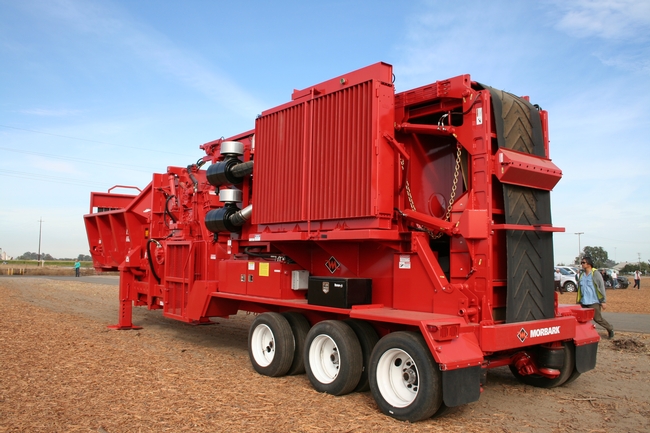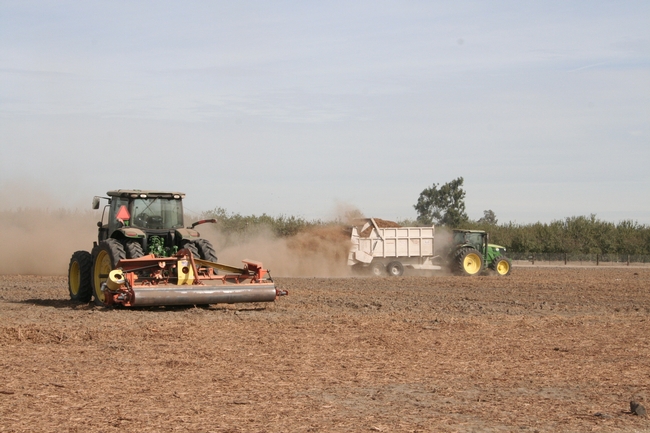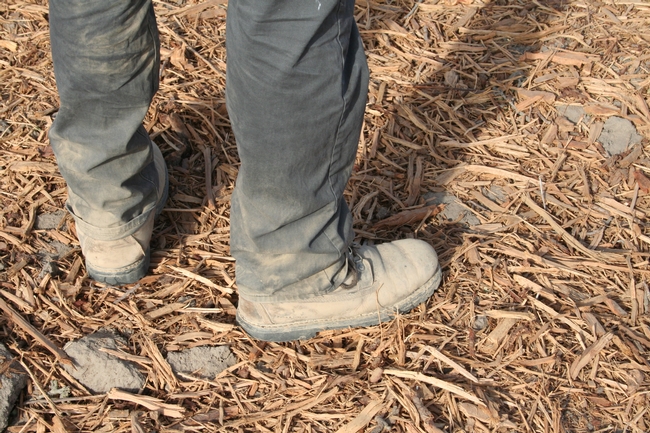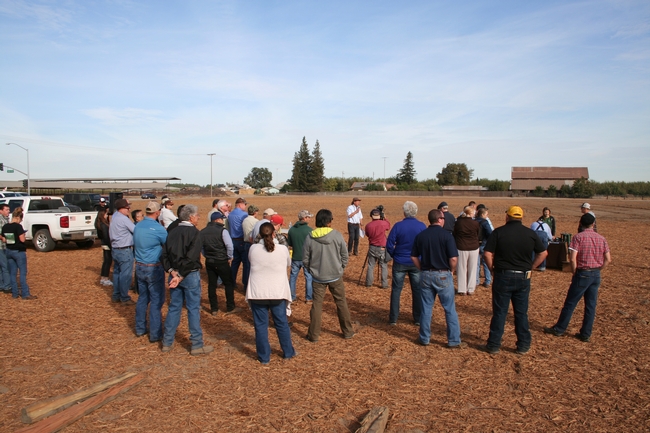- Author: Jeannette E. Warnert
The numbers are beginning to trickle in confirming UC Cooperative Extension advisor Brent Holtz' hunch. Chipping and returning expired almond orchards into the soil where they grew is not only environmentally sound, it is economically smart.
(View a three-minute video of the machinery in action at the end of this post.)
After about 20 years, almond orchards' productivity and vigor begin to decline. Most farmers remove the old trees and plant younger, more vigorous replacements to keep up almond production.
In the past, old trees were easily and cheaply disposed of: they were pushed into a pile and set on fire. Air quality regulations have all but eliminated the practice.
At first, grinding the trees and sending the chips to a co-generation plant was a farmer's preferred option. The companies that used biomass for electricity generation paid an acceptable sum – about $600 per acre – for the wood chips, which helped offset the cost of chipping and hauling the trees off the property.
However today, electrical utilities are looking for clean, renewable energy sources like wind and solar.
“Cogeneration plants burn wood biomass, which still releases carbon dioxide and methane into the atmosphere,” Holtz said. “Many are losing contracts and shutting down.”
Holtz sought another cost-effective alternative, and believes incorporating the wood into the orchard floor may be the answer. Although initially expensive, adding $400 per acre to the $600-per-acre cost of chipping the old trees, the organic matter and nutrients released by the woodchips over time appear to boost yield to a level that covers a chunk of the cost.
In preliminary research, Holtz found that almond orchards where old wood was incorporated into the soil were averaging about 1,800 pounds of meat nuts per acre, while the orchard where old trees had been burned averaged 1,600 meat nuts per acre.
“Almonds sell for about $2 to $3 per pound. To have a 200-pound average yield increase per acre, you've made up the cost of incorporating the wood in just one year,” Holtz said. “It would be even more affordable if farmers can sell carbon credits for the biomass that they sequester in the ground.”
Holtz recently demonstrated two approaches for incorporating almond trees into the soil. The first, which was also used in the study eight years ago at the UC Kearney Agricultural Research and Extension Center in Parlier, is a 50-ton rock crusher called the Iron Wolf. It lumbers down the tree row, grinding up whole trees in place, then reverses over the mangled wood to incorporate it into the ground.
“We thought this one-machine process was the answer,” Holtz said.
G & F Ag Services in Ripon, which has made a business of chipping and hauling almond wood to a co-generation plant, conceived another plan. It modified a manure spreader to spray ground-up wood chips across the orchard floor. Holtz worked with Manteca farmer Louie Tallerico to give the new process a spin.
“This required five different machines working together compared to one Iron Wolf. In this process, the trees have to be excavated by an excavator, then hauled to the wood chipper with a front-end loader. The trees have to be fed into the wood chipper, then the wood chips have to be spread on the orchard floor,” Holtz said. “Another machine, a disk or roto tiller, incorporates the chips into the soil.
The five machines combined are a tremendous time saver.
“The Iron Wolf could do about two acres per day,” Holtz said. “This process can do 15 or 20 acres per day.”
Tallerico opened his farm for a field day in October to demonstrate parts of the process to other farmers and industry representatives. Participants stood on layer of fresh-cut wood chip mulch where a full-grown almond orchard stood just weeks before. The spreader demonstrated the ease with which the wood chips are dispersed evenly across the orchard floor, and a tiller mixed the wood chips into the soil.
The Tellarico orchard will now be the site of research – funded by the California Almond Board – to be conducted by Holtz and a team of scientists interested in documenting the growth and development of the new almond orchard among the remnants of its predecessor.
“In the previous study, three years after incorporating the old trees into the soil we started to see the nutrient benefit,” Holtz said. “This was done at Kearney, where we incorporated a peach orchard that had about 30 tons of organic matter per acre. Almond trees are larger, so here we have 86 tons of organic matter being returned to the soil.”
In the new study, the scientists will determine whether the nutrient benefits found in early research still hold true, whether the wood chips in the soil stunt the new orchard or boost its growth, whether the new orchard suffers from replant disease, and the fate of good and bad nematodes (tiny soil-borne worms) in the new orchard.
“We will also study the carbon budget and continue the life cycle assessment of almond with this practice, to better understand the benefit of these processes,” Holtz said.







